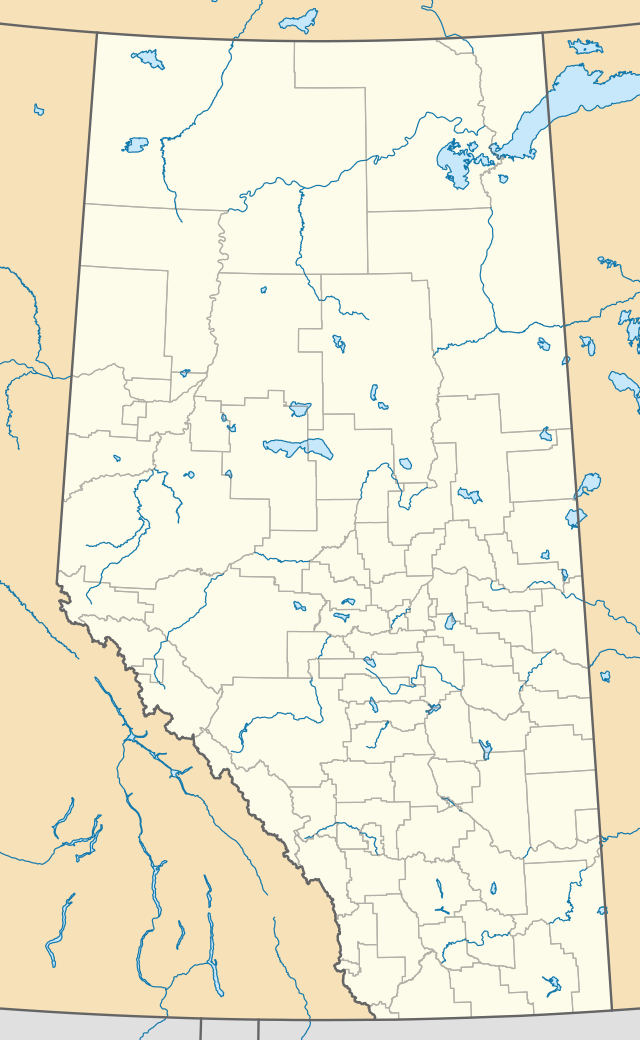Cayley, Alberta
Cayley is a hamlet in southern Alberta, Canada within the Municipal District (M.D.) of Foothills No. 31.[2] It is also recognized as a designated place by Statistics Canada.[3]
Cayley | |
|---|---|
 Location of Cayley in Alberta | |
| Coordinates: 50.4481°N 113.8472°W | |
| Country | |
| Province | |
| Census division | No. 6 |
| Municipal district | M.D. of Foothills No. 31 |
| Government | |
| • Type | Unincorporated |
| • Reeve | vacant |
| • Governing body | M.D. of Foothills Council
|
| Area | |
| • Land | 0.48 km2 (0.19 sq mi) |
| Population (2016)[1] | |
| • Total | 340 |
| Time zone | UTC-7 (MST) |
Cayley is approximately 73 kilometres (45 mi) south of Calgary, 13 kilometres (8.1 mi) south of High River and 1.2 kilometres (0.75 mi) west of Highway 2 on Range Road 290 (former designated as Highway 2A). It is located within Alberta Census Division No. 6.
History
The community was named for the Hon. Hugh St. Quentin Cayley, a barrister and the publisher of the Calgary Herald in 1884, who also represented Calgary in the Northwest Territories legislature from 1886 to 1894.[4] The hamlet originally contained at least seven grain elevators; all have been demolished. Cayley is also home to a Hutterite colony and a colony school; in 2001, two Cayley Colony girls were the first students from an Alberta colony school to write provincial diploma exams and graduate from high school.[5]
Demographics
As a designated place in the 2016 Census of Population conducted by Statistics Canada, Cayley recorded a population of 340 living in 143 of its 143 total private dwellings, a change of 28.3% from its 2011 population of 265. With a land area of 0.48 km2 (0.19 sq mi), it had a population density of 708.3/km2 (1,834.6/sq mi) in 2016.[1]
As a designated place in the 2011 Census, Cayley had a population of 265 living in 97 of its 104 total dwellings, a -18.5% change from its 2006 population of 325. With a land area of 0.54 km2 (0.21 sq mi), it had a population density of 491/km2 (1,271/sq mi) in 2011.[7]
| Year | Pop. | ±% |
|---|---|---|
| 1926 {est.} | 135 | — |
| 1936 | 135 | +0.0% |
| 2011 | 265 | +96.3% |
| 2016 | 340 | +28.3% |
| Sources: | ||
See also
References
- "Population and dwelling counts, for Canada, provinces and territories, and designated places, 2016 and 2011 censuses – 100% data (Alberta)". Statistics Canada. February 8, 2017. Retrieved February 13, 2017.
- Alberta Municipal Affairs (2010-04-01). "Specialized and Rural Municipalities and Their Communities" (PDF). Archived from the original (PDF) on 2012-02-29. Retrieved 2010-06-24.
- Statistics Canada (2007). "Population and dwelling counts, for Canada, provinces and territories, and designated places, 2006 and 2001 censuses". Retrieved 2010-01-30.
- "Hugh St. Quenton Cayley biography". Southern Alberta Pioneers. Retrieved 2007-12-07.
- "Alberta Teachers' Association - In the News - Two firsts for Cayley Colony School". Archived from the original on 2007-09-27. Retrieved 2006-11-13.
- Alberta Queen's Printer (1996-04-24). "Order in Council (O.C.) 173/96" (PDF). Retrieved 2010-06-24.
- "Population and dwelling counts, for Canada, provinces and territories, and designated places, 2011 and 2006 censuses (Alberta)". Statistics Canada. 2012-02-08. Retrieved 2012-04-06.